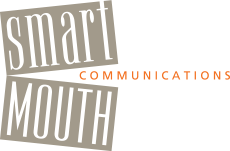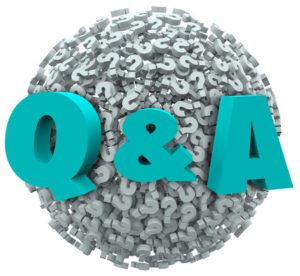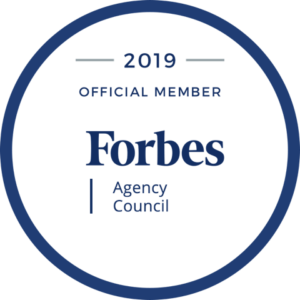SmartMouth Talks!
Ode to Voice
Last week, I lost my voice. Literally, I couldn’t talk. Laryngitis.
Naturally, I joked about it: The ironies of a communication coach not being able to speak – what good am I in this condition? What a pleasure and relief for my family – finally, a break and some much-wished-for silence! My own vocal chords were on strike – was it something I said?
I also wondered. When will it come back – a day, a week, longer? Who am I without my voice? Am I relegated to communicating digitally only? What did people with laryngitis do before texting and emailing?
I will admit, sudden onset of laryngitis prompted some panic and an existential crisis: Whoa, where did this come from, what did I do to bring this on? What would I do if I had to deliver a speech or presentation in this condition? Cancel, reschedule, or create a killer PowerPoint or video? How could I turn this seemingly negative event into a positive? (Maybe blog about it?) My livelihood depends on my voice, what would I do if this persisted?
Turns out, I was still me; I had the same thoughts, ideas, and feelings. I just couldn’t share them – vocally, that is. It also turns out, the people around me were at a little bit of a loss without the all-too-familiar sound that drove through my larynx – my news, my bad jokes, my unsolicited opinions and everything else I rattle off in the course of a day. It was quite interesting to observe how people reacted to my inability to speak, including the pharmacist who, perhaps in an attempt to empathetically mirror my limitations, gradually dropped his own voice to a raspy whisper to answer my barely audible questions.
The experience made me think about voice and the fact that it’s not my voice that I lost, it was only my ability to talk. I couldn’t talk. But I had a voice and could give voice without being able to make much sound. I could communicate. So as with any other change that occurs in life – for the better or the worse – I decided that, if this stayed with me, I would adapt. I would still communicate and spread my ideas (like the gospel of #audience-centricity!) through writing. Maybe I would work on another book and share my thoughts that way instead of through speaking engagements? Maybe I would become a speechwriter, creating the actual words for speakers instead of coaching them to formulate and deliver their own? Either way, not being able to talk was not going to be the end of me.
 Talking, I have realized, is overrated and overused (ergo, the gospel of #brevity!). Communication is the constant, it has evolved in infinite ways over the years, and adaptation is a constant too. Think about how we have communicated news for example. News was once shared via petroglyphs etched into rock and then eventually via newsprint on paper and currently via electronic transmission on a screen. And there are other examples as well, most notably the arts – visual arts, music, dance – all of which give voice and communicate but not necessarily through talking. Voice, which can and should be carefully cultivated and deployed, is something we all have no matter what. The various methods of communication at our disposal is how we share our precious voices.
Talking, I have realized, is overrated and overused (ergo, the gospel of #brevity!). Communication is the constant, it has evolved in infinite ways over the years, and adaptation is a constant too. Think about how we have communicated news for example. News was once shared via petroglyphs etched into rock and then eventually via newsprint on paper and currently via electronic transmission on a screen. And there are other examples as well, most notably the arts – visual arts, music, dance – all of which give voice and communicate but not necessarily through talking. Voice, which can and should be carefully cultivated and deployed, is something we all have no matter what. The various methods of communication at our disposal is how we share our precious voices.
P.S. About two days later, my voice returned – albeit not in fighting condition and still on the mend. Nevertheless, existential crisis averted and lesson learned: I never lost my voice and I never will.
Good to Great Speaking
 What does it take to go from being a pretty darn good speaker – well organized, prepared, on point – to being a great speaker? To being someone who is compelling, thought-provoking, thoroughly engaging, and memorable?
What does it take to go from being a pretty darn good speaker – well organized, prepared, on point – to being a great speaker? To being someone who is compelling, thought-provoking, thoroughly engaging, and memorable?
It takes getting naked. Yep, baring it all. Opening up. Sharing. Being vulnerable. Being real.
Audiences crave earthy, gritty, revealing, personal. They want to be drawn in, they want to see and know. Let’s face it, it’s what we’ve become accustomed to in our digitally oriented lives [think: social media]. All that openness and sharing – even the cringy oversharing – has created an expectation and an appetite for not just the what, where and how, but also for the how does it feel.
It’s perfectly acceptable and more than adequate to speak and be organized, prepared and totally on point. In fact, it’s way more than adequate (since too few speakers are!). It makes you good, really really good.
But to be great? That requires you to open up. Connect with your audiences, let them see and know you. Share your failures as well as your successes, share your fears as well as your hopes, share your vulnerabilities as well as your strengths and passions.
Share what makes you doubt yourself and what makes you tick, what scares you and what excites you. Share what you regret as well as what you are proud of. Share what gets you motivated in the morning as well as what you dread. Be relatable.
There’s a lot to be gained – and nothing to be lost – by connecting with your audiences on a deeper level. Make a note of the reactions and comments you get from people after you bare it all. I’m willing to bet it will result in more robust feedback and far greater buy-in and engagement. And that’s the difference between good and great speaking.
How to Stop a Hijacker
 Last week, I was delivering a workshop on Executive Presence and Communication to a group of high-potential executive women at a large financial services firm. As always, I encouraged the group to share relevant stories and anecdotes at any time during our half-day together.
Last week, I was delivering a workshop on Executive Presence and Communication to a group of high-potential executive women at a large financial services firm. As always, I encouraged the group to share relevant stories and anecdotes at any time during our half-day together.
During the segment in which we addressed the special challenges of being commanding and confident on conference calls and in videoconferences, one of the women spoke up to ask a question:
She started by sharing a story from the day before about a presentation she had made that became an extremely frustrating and disappointing experience. Her presentation was a demo; half of the audience was in the room and half on the phone, with everyone looking at the same screen. She had prepared for a week. As she described it, she began the presentation and, not a few minutes into it, a male colleague who was on the phone jumped in and took over most of the rest of the talking.
Her question for me and the group was, “what should I or could I have done to stop him?” She noted that he had a company-wide reputation for talking over others and out of turn and she characterized it as a bad case of mansplaining.
Was this a case of mansplaining? Maybe, but it’s hard to say since both genders are guilty of this sort of thing. But for sure it was a case of what I call hijacking. So let’s talk about a few ways to stop hijackers in meetings and presentations:
-
Set agreements and be clear about roles and responsibilities in the meeting or presentation with colleagues in advance. If it needs to be a co-presenting situation, then be specific about that in the meeting invite so everyone knows, and also be deliberate in how the preparation work is divided (i.e. make sure everyone who is presenting carries a proportionate load of the prep work). If the presentation is solely yours, make that known too by letting attendees know there will only be one speaker, how long you plan to speak for, how long Q&A will be, and that there will be others on the team present to help fill in during Q&A.
-
Use a Focal Point that helps establish what’s going to happen during the meeting and what the desired outcome is. For example, in a presentation like the one above, in which there’s a demo to introduce new software, and other team members are in on the call, the Opening/Focal Point might sound something like this: “I will be walking you through the demo, which should take about 15 minutes. After that, we will have another 15 minutes to answer your questions and fortunately several team members [names] are also here and can help answer your questions. By the end, I am hoping you’ll feel like you have a solid introduction to the new software, which should make it considerably easier for you once we go live.”
The Focal Point sets clear expectations and gives you a “home base” to return to in the event of a hijacking. In other words, you can always break in on your hijacking colleague’s stolen air time and say, “Rob, I know you’re as eager as I am to make sure everyone appreciates all the advantages of this new software but let me get through these initial screens so that everyone gets the same solid introduction and then you can add to what I’ve gone over once we break for Q&A.”
-
If you’ve done the best you can do by employing the above suggestions and you still get hijacked, then I would revert to directness wrapped in good manners, which is a nice way of saying, go ahead and interrupt the hijacker! Wait for the person to pause or take a breath and then interrupt directly and politely. For example, “Rob, thanks for sharing your input, you’ve been a great contributor to the team that’s put this together. Now, if we look at the screen where I left off, you’ll notice the navigation … “
At the end of the day, hijackers are usually known quantities in an organization and when they do it repeatedly and predictably, it’s a poor reflection on them, not you. Nonetheless, especially if you’re anticipating the possibility of being hijacked, then you would be wise to plan ahead with the suggestions I shared above. Good luck out there!
Stories Made Simple
 Stories – or anecdotes, examples, case studies – are the absolute best way to illustrate a point, even in a business presentation.
Stories – or anecdotes, examples, case studies – are the absolute best way to illustrate a point, even in a business presentation.
When crafted well, they illustrate and support your messages better than anything else. Stories make an emotional connection to your audience that sticks with them long after you finish talking.
Here are 3 rules of thumb that apply to using stories in your communications:
1. STORIES NEED TO DIRECTLY SUPPORT A POINT. In other words, you may have a favorite story that you love to tell, and that’s great, but it must be constructed in a such a way that it works its way to a “punch line” that reinforces the message point you are trying to support. You can’t assume the audience will make that connection on their own, you have to spell it out and tie it together for them.
2. PREPARATION IS ABSOLUTELY NECESSARY. Rather than simply reminding yourself to tell a certain story during your presentation, you need to map out the story to avoid getting lost in the details while telling it (every story has more details than you have time to share!). I have watched too many speakers derail a perfectly good 15-minute presentation by telling a story that went on and on until – before they knew it – an additional 10 minutes of air time had been consumed.
3. SIMPLE IS MORE EFFECTIVE THAN COMPLICATED. This is true of most communications but certainly true of stories – despite the temptation to “spin a yarn” for your audience. Unless you’re a comedian or a professional storyteller, you’ll want to keep your stories simple.
Keeping them simple means paring down and prioritizing the detail. Think about composing your stories in this 3-3-3 format:
-
3 sentences describing the situation;
-
3 sentences revealing the dramatic tension (e.g. something unexpected, complications, competing factors); and
-
3 sentences outlining the resolution, which should help you tie back – in that punch line kind of a way – to the point you were illustrating.
And finally, be sure to cue your audience when you’re beginning and ending a story. For those in the audience who might not be paying close attention, you have the opportunity to reignite interest with your own appropriate versions of “Once upon a time” and “The end” – those timeless story cues that signal the open and close of something special.
Simple Twist on Conveying Value
 Have you ever been asked the question, “So what are you working on these days?” Or, have you ever been called on to explain a project or initiative you are leading?
Have you ever been asked the question, “So what are you working on these days?” Or, have you ever been called on to explain a project or initiative you are leading?
If so, are you happy with your answers? Do you feel like you’ve conveyed value or benefit? Or did you merely tick off a laundry list of to-do items or perhaps a project checklist?
Regardless of where you are in your organization or career, it’s critical to be able to communicate the value of your work, both internally (to colleagues and superiors) and externally (to clients, customers and suppliers).
Fortunately, it’s quite easy to articulate value. It’s simply a matter of adding a clause to the end of any to-do item, so here are 3 of the easiest clauses to add:
- … so that …
- … which will result in …
- … that will have the added benefit of …
Adding these clauses, along with the words that follow, can completely change the nature of your answer and – more important – the impression you leave with your audiences. Add a clause, convey the value. It’s that simple.
Did You Know?
Gearing up to make a speech or presentation can be daunting for two main reasons – one is the challenge of organizing your thoughts and material into something interesting and compelling; the other is the challenge of managing yourself, your nerves, and the dread that comes with anticipating the faces, opinions and judgment of an audience.

For the first one, click on the highlighted link to access our tool that can help you. But for the second one, let’s try and put that into perspective right here, right now.
To that end, I’d like to offer 3 proven facts for you to use as “notes to self” when you find yourself thinking up excuses you can use to back out of your speaking commitment. I bet you didn’t know – or maybe when anxious, you’ve suppressed – these 3 tested and true facts:
Did you know that …
1. Audiences cannot tell you’re nervous.
Unless you call it out or unless it’s very – and I mean very – exaggerated, audiences cannot tell you’re shaking, not breathing normally, or sweating. There have been surveys around this, and it turns out the vast majority of audiences cannot see the manifestation of nervousness in speakers. Anecdotally, I can tell you I’ve worked with groups in which the participants have had to give mock presentations to each other and – without fail – these peer audiences have not noticed when their colleagues were shaking or couldn’t breathe. Interesting!
Bottom line: Know that what you are feeling, while it seems blatantly obvious to you, is going to be invisible to your audience. And no matter what, don’t call it out!
2. Audiences don’t know when you’ve skipped or forgotten something.
Of the many ways to fluster yourself, skipping or forgetting a chunk of your material while delivering your talk is right up there on the list of top flusterers. Nonetheless, I can guarantee you that you’ll be the only one distracted by it. Your audience won’t know. So even if, worst-case scenario, you moved clumsily from your first point to your third point and it sounded like a non-sequitur to your audience, they’ll get past the rough transition and join you in your third point … and they still won’t know.
Bottom line: Know that what you skipped, while it seems like a blatant omission to you, is not noticeable to your audience. And no matter what, don’t call it out!
3. Audiences are on your side, they expect you to succeed.
Yes, the home court advantage is yours! Audiences are passive, they’re just waiting for – and expecting – you to do a good job. In fact, they’re glad the responsibility is on someone else, and they assume that since you were invited to go to the front of the room, you have the gravitas for it and you’ll do just fine. No one is sitting there waiting for you to fall on your face (like you might be?). Your audience is waiting for you to connect with them and offer them something of value, something new or useful. So be sure to do that!
Bottom line: Know that your audience is not judging you harshly, they’re actually waiting for you to enlighten them. And no matter what, don’t open with disclaimers or qualifiers about how prepared/unprepared you are or how confident/insecure you are about your topic.
Audiences are people, just like you. Observe yourself when you’re listening to a speaker/presenter and make more “notes to self” that will help you the next time you get up to speak!
Multitasking
 Last week, I delivered four different talks, all of which were the full monty – large audiences, microphones, PowerPoint decks, four different topics. It was daunting, but not because of nervousness or fear of forgetting my content. It was daunting because of all the multitasking involved with, and required of, being a good speaker.
Last week, I delivered four different talks, all of which were the full monty – large audiences, microphones, PowerPoint decks, four different topics. It was daunting, but not because of nervousness or fear of forgetting my content. It was daunting because of all the multitasking involved with, and required of, being a good speaker.
There are multitudes of public speaking worries that are talked about, yet for some reason multitasking is one that gets woefully overlooked. For me, and for many, the multitasking involved in being an effective – let alone, dynamic and compelling – public speaker might well be the most taxing aspect of going to the front of the room.
Here’s a random sampling of what multitasking looks like for me:
Do I look okay?
Am I smiling and appearing welcoming?
Is the sound working?
Am I projecting well enough?
Is the technology working?
Was I compelling in my first 8 seconds?
Am I connecting with this group?
Am I transitioning well from slide to slide, section to section so that it makes sense to them?
Am I moving around the floor too much/too little?
Is my speaking pace okay?
Am I providing enough time for them to digest the material?
Am I looking around the room at as many faces, or segments of the room, as possible?
Should I engage them now, should I maybe break for a midpoint Q&A?
Are they with me, do they get it?
How’s my energy, voice and body?
Am I sensing that the next section of my content won’t really interest them, should I skip it?
Are my glances at the screen subtle and few?
Am I hitting all the points I planned to make and, wait, do I remember what comes next?
Can you relate to some, or maybe all, of these? Are you with me, do you get it? I’m guessing the answers are yes and yes. Is it overwhelming and sometimes literally daunting? Yes and yes.
There’s no single cure or technique for conquering or mastering multitasking, but here are 3 basic tactics that can provide some relief:
1. Know your content. Be fluent with the flow, especially with the actual statements (i.e. the sentences) that are your major message points. Pay attention to and prepare your transitions and pauses.
2. Plan not only your content, but your choreography too – you, your visuals, your body language and gestures, your movement around the stage or room. Know, and then rehearse, your choreography with your content.
3. Let her rip! At a certain point, you need to let go of all your multitasking worries and just be present with your audience. Release yourself to them, talk to them, be with them and trust that you’re prepared and the rest will come.
It all boils down to this: good preparation. And then, even with good preparation under your belt, when it’s show time, you need to let go and be with your audience.
Good luck out there, and let me know how it’s going!
The Only Thing That Matters
 Have an upcoming presentation? Sweating it? Don’t know where to begin?
Have an upcoming presentation? Sweating it? Don’t know where to begin?
The only thing that matters, the one and only thing that should guide you – along with your topic, of course – is your audience. Yes, it’s that simple: your audience makes all critical presentation decisions for you.
As you develop your main ideas or key message points for your presentation, your audience is your go-to source for inspiration. Think about who they are and what they really care about? Who are they – peers, colleagues, influencers, decision-makers? What do they really care about – time, money, impact, quality, their own jobs? What’s in it for them, what keeps them up at night? And therefore, what are the main ideas or themes you should hit on?
Angle your material toward your audience.
Think about why they are in the room. Are they obligated to be there? If so, keep it brief and avoid TMI. Or did they choose to be there? If so, you have a little more latitude with time and detail.
You also will want to plan to bring them along on the journey that is your presentation. What I mean by that is you will literally want to bring them along, you will want to guide them through your presentation – e.g. letting them know where you are, what’s next, what their takeaways are supposed to be, when you’re digressing to share a story, and when you’re back on track.
Audiences are passive and are not required to work hard. You, the speaker, are in the active role and are required to work hard. The work of building understanding, appreciation and/or aha! moments is on you, not on your audience. You bear the responsibility of guiding them through your material and toward your conclusions, you cannot assume they’ll get there on their own.
The solution in a word? Spoonfeed. If you want your audience to know or understand or do something, spoonfeed it, spell it out. Otherwise, it is likely to be lost. People do not connect their own dots.
Just remember that audiences will not do any work to figure out what you’re telling them. They are waiting for you to give them something new or useful or worthwhile. Above all, they are waiting for you to give them something that’s valuable and relevant (to them, not to you).
Think about it, angling your material toward what you know about your audience’s interests is the least you can do in exchange for their time and attention!
Questions for the Audience
 If you’re delivering a talk or presentation, questions are your best friend.
If you’re delivering a talk or presentation, questions are your best friend.
I’m not referring to the questions your audience asks you during Q&A – no doubt, those are really important too – but I’m referring to the questions you ask your audience.
Here’s my triple-win rationale for speakers posing questions to their audiences:
First, if you tend to get nervous, you can throw a question or two to the audience as a way to give yourself a little breather. The first 120 seconds of a presentation are the most anxiety-provoking – that’s when you’re the most nervous and probably not breathing normally – and so posing a question to the audience will give you an opportunity to share the floor and grab enough time for a nice, hopefully calming, inhale and exhale.
Second, we all know from our experience as audience members that we like to be engaged, it holds our attention better. Questions therefore are a great tool for connecting with and engaging your audience – inviting them to access their own knowledge or experiences around your topic, making them question biases or misconceptions about your topic, getting them to think. These are all good, as they will help you open your audience’s minds to hear what you have to say.
Third, questions are a change in stimulation during a talk or presentation. They are attention-grabbing and will wake up any sleepers or daydreamers in the room. I often get asked how to bring back an audience’s attention when you feel like they’re fading or drifting. Well, asking them questions is one perfectly good way!
Here are three tips for using questions effectively:
1. Prepare your questions in advance and know when you’re going to ask them. Note of caution: You’ll also need to be ready to answer the questions yourself in the unlikely, but possible, event of radio silence from the audience.
2. Make sure the questions do a good job of queuing up your next point – or, in the case of an opening question, queuing up your whole talk.
An example of this is a sports arena executive I worked with a few years back who was often invited to speak to Rotary Clubs and other local business groups. He would open his presentations by asking his audiences to guess how many rolls of toilet paper they thought the arena went through in a year. This was such an entertaining way to spark the audience’s thoughts about the vast numbers of visitors and diversity of events at the arena, which supported his overall message that the arena entertains an entire region!
3. If you ask a question and people answer, please be sure to acknowledge and repeat back as many of the answers as you can. This not only fuels the engagement between speaker and audience, but it also recognizes audience members for making an effort.

 Managing Q&A effectively requires you to have a good offensive game strategy. What this means is being mentally ready with an approach for how you want to field and answer questions no matter what you get asked.
Managing Q&A effectively requires you to have a good offensive game strategy. What this means is being mentally ready with an approach for how you want to field and answer questions no matter what you get asked.

